All aviators know-- -- that AoA at stall is NOT affected by variances in aircraft cabin or fuel loads, or by density altitude or by angle of bank, but light aircraft have never really had a good AoA indicator available at a reasonable cost. Now we do.
From a Falcon 20 Captain in Louisiana MO, Jim Osborn:
"Fred Scott's kind invitation for me to evaluate the freshly installed in his Blackhawk King Air 90 was an offer much too good to pass up.
"So on a rather skuzzy Sunday morning in 2010 at Pittsfield Illinois I boarded 'Studly' (as Fred aptly named his muscular aerial steed) anxious to see firsthand whether the Alpha Systems 'Legacy' AoA - one specifically designed for GA aircraft and costing mere peanuts compared to highly complex mega-bucks models that I'm familiar with in the corporate world - could possibly meet the same standard of performance known from my experience with the latter. So, how did it do?
"In a word - STUNNINGLY! This Alpha Systems "Legacy" model AoA is intuitive, unambiguous and accurate to a "T", as was demonstrated while we methodically maneuvered through pretty much the same flight envelope that Fred and his skilled associates followed when originally calibrating and testing the installation. I could not have been more impressed with both product and performance. In fact it has more fine features than the big-iron units. It is a brilliantly designed system that harnesses the laws of physics simply, displays color-coded commands vividly, and provides aural alerts when appropriate. A device like this must have been the very thing the FAA was hoping to see, eventually. As I was studying for my Certified Flight Instructor rating FORTY-SIX YEARS ago, I underlined my:
FAA Flight Instructor's Handbook - 1964
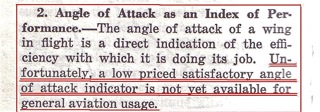
"For me, the immediate take-away from our flight is a dramatic reminder that - in addition to its other remarkable virtues (such as pegging the green bulls-eye command like crosshairs on a gun sight to "nail" an approach speed ) - AoA is the ONLY warning device available (visual, aural or tactile) that independently and continuously provides crucial slow-speed alerts far before traditional stall warning devices can detect that airspeed and lift have decayed below safe flight conditions.
"Natural control response to Legacy's several illuminated segments intuitively keeps one on the SAFE SIDE OF AERODYNAMIC STALL under all flight conditions - no matter the maneuver and regardless of weight, attitude or indicated airspeed (including no airspeed indication at all, if need be). 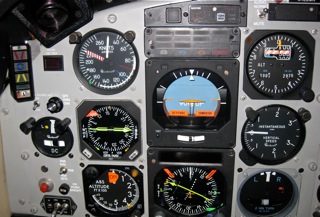 As an operational side note: there's no need to look directly at the segmented display to know that things in the lift department are "A-OK" (or not) because the bright AoA visual cues remain within the pilot's peripheral vision, which makes its color-coded display virtually impossible to ignore even when otherwise distracted. As an operational side note: there's no need to look directly at the segmented display to know that things in the lift department are "A-OK" (or not) because the bright AoA visual cues remain within the pilot's peripheral vision, which makes its color-coded display virtually impossible to ignore even when otherwise distracted.
"Here's the BIGGEST payoff, in my opinion; the one that sparked Fred and Tom Rosen to launch their all-out AoA educational blitz to the GA community. Angle of Attack is without doubt THE ONE DEVICE actually capable of STOPPING the appalling carnage caused by base-to-final and low-altitude departure-stall/spin accidents. These are the very type of accidents that claimed the lives of Fred's & Tom's dear friends, and to whom their AoA educational work is dedicated; the tragic loss of four VERY experienced and VERY skilled aviators who in two separate accidents, somehow, while distracted by events of the moment, got TOO SLOW and remained unaware until too late to recover from inevitable disaster.
"We'd not be discussing these sad events IF ONLY those skilled pilots' attention had been drawn to pre-stall conditions in time to avert such imminent danger and recover; conditions which neither , nor currency, nor were sufficient at the critical moment to avoid, sans AoA.
This clip from the is important: "Student pilots are the least likely to suffer stall/spin accidents ....Pilots holding FAA Airline Transport Pilot (ATP) certificates are also less likely to stall/spin.
"That leaves pilots with FAA private and commercial pilot certificates in the 'most likely to suffer fatal stall/spin accidents' category. In fact, ..."
"An instructor on board is no guarantee. In reviewing 44 fatal stall/spin accidents from 1991 - 2000 and classified as instructional, ASF found that a shocking 91%(40) of them occurred during dual instruction, with only 9% (4) solo training flights...."
Following up in 2015,
Osborn continues: "Thanks to the engineering genius of folks like Mark Korin at , now comes his line of Angle-of-Attack systems (so simple and yet astonishingly affordable) that portends triumph over tragedy. And thanks to our friends and their like-minded associates, the GA community is getting a needful and unprecedented education about AoA thru this timely body of research.
"My bottom-line thoughts are these: Learn all you can about AoA - then get one!
Want to learn more? Years ago, the
|
C.K. Lee flies a nice Baron out of Addison TX. He had never seen an AoA and had never flown a King Air:
"So Fred Scott was headed to Austin in his King Air (with an angle-of-attack indicator installed). Would I be interested, he asked, in going for a ride and learning about the instrument and how it worked? Does Charlie Daniels play a mean fiddle?
"Jack Stovall, another Beech Baron owner, met us in Georgetown, TX and we blasted off for the practice area. While Jack and Fred are familiar with AoAs, this was a first for me. Fred has the Legacy AoA displays mounted on both upper corners of the panel - easily included in the pattern scan, nearby and at the same level as the airspeed indicator. The display is arranged fairly intuitively 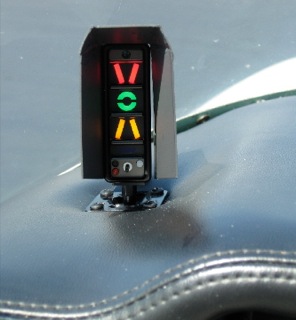 - a bifurcated donut in the middle ("ON SPEED"), a yellow chevron on the bottom ("You're OK, just a bit fast") and a red chevron on the top ("Danger Zone Ahead!"). [Here, the display is in Self-Test; in flight, we only see one or two segments.] While it clearly is a secondary instrument and a supplement to the airspeed indicator when maneuvering, after a few minutes of use I was able to integrate it into my scan and keep the wing at whatever load levels I chose. - a bifurcated donut in the middle ("ON SPEED"), a yellow chevron on the bottom ("You're OK, just a bit fast") and a red chevron on the top ("Danger Zone Ahead!"). [Here, the display is in Self-Test; in flight, we only see one or two segments.] While it clearly is a secondary instrument and a supplement to the airspeed indicator when maneuvering, after a few minutes of use I was able to integrate it into my scan and keep the wing at whatever load levels I chose.
"Jack and I swapped out doing slow flight, stall series, steep turns, simulated traffic patterns etc. all between 80 and 110 KIAS. It was easy to pick up the relationship between the gauge and what was happening out on the wing. On steep turns, for example, you could keep a fairly constant airspeed and move the AoA indicator up and down the scale just by pulling and pushing - and at every phase having a good understanding about how far you were from stalling the airplane. The visual indications are accompanied by audible warnings during the transition from yellow approach speeds to the green donut.
"So - what are my thoughts? 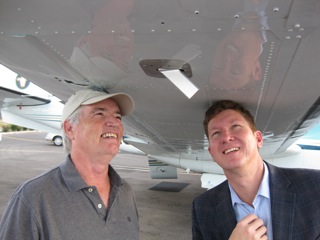 First, I think the instrument provides great data on the 'gray area' between published straight-and-level stall speed (which most of us know off the top of our head) and the actual stall speed at the angles of bank and speeds we use in the traffic pattern. We all know (or should know) that the stall speed goes up with angle of bank (or wing loading) - but in the real world we rarely know the precise speed - under every possible scenario - at which the wing will let go. And it certainly isn't a calculation we make when we're mentally loaded up in the pattern, looking for traffic, spotting ground reference points and pulling for the runway. Many of us, unfortunately, and the would seem to bear this out, First, I think the instrument provides great data on the 'gray area' between published straight-and-level stall speed (which most of us know off the top of our head) and the actual stall speed at the angles of bank and speeds we use in the traffic pattern. We all know (or should know) that the stall speed goes up with angle of bank (or wing loading) - but in the real world we rarely know the precise speed - under every possible scenario - at which the wing will let go. And it certainly isn't a calculation we make when we're mentally loaded up in the pattern, looking for traffic, spotting ground reference points and pulling for the runway. Many of us, unfortunately, and the would seem to bear this out,
"Most of us are able -- thankfully, through a combination of good traffic pattern management and plenty of airspeed buffer -- to avoid this scenario. But this instrument seems to fill the gap - through both the visual presentation and the audible warnings - to help us focus back on the airplane's configuration as we APPROACH the danger zone rather than AFTER IT IS TOO LATE.
"I have a lot of experience in my plane and have a good sense of how it behaves in a typical pattern into a typical runway. Where I think it would pay off for me is those situations (three or four times a year) when I'm heading into our short farm strip in Florida or the little grass strip where we go for lunch sometimes. In those situations the distraction levels are higher than normal and maintaining a precise (and very low) airspeed is more critical than when landing at my 5,000ft. runway at my home base in Dallas. The AoA indicator, helping me understand exactly how much margin I have during the maneuvering phase would be a nice supplement to the airspeed indicator.
"I think the real payoff would be for newer pilots, providing them -- far beyond the theory they learn or the controlled situations when they do accelerated stalls -- a constant demonstration of the relationship between wing loading and stall speed. Integrating this into the training regimen would help prevent, in my view, the all-too-frequent screw-up resulting in a stall/spin fatality in the pattern.
"The instrument would also be useful in transitioning to a new airplane. A visual presentation of exactly how much margin you have at any given time would assist pilots transitioning to newer, higher performance airplanes
"Fred also asked for suggestions on improvement. The visual display is fine, very intuitive and I adapted quickly. Obviously, AoA calibration is key and there is a chance that some airplanes will be calibrated to warn at 1.3x dirty stall speed and others at 1.3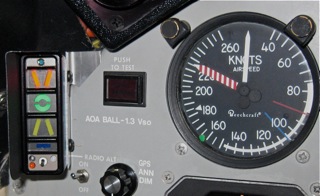 x clean stall speed. A placard indicating the speed being defined by the donut would better clue the pilot into the context for what he's being shown. [A great idea! Done, as seen to the right]. The audible 'three-beep' warning I heard might be re-programmed as a unique '"Deedle-Deedle"' tone. The modern cockpit has a lot of beeps and we want this one to stand out and quickly direct you to the problem. One of Fred's other demo-pilots suggested a simple 'Getting Slow' voice warning [Done. Listen to Slow Sarah - "Getting Slow"] as you approach 1.4 Vso -- and I think that would work well as a gentle reminder to, as Fred says, 'be careful, son.' x clean stall speed. A placard indicating the speed being defined by the donut would better clue the pilot into the context for what he's being shown. [A great idea! Done, as seen to the right]. The audible 'three-beep' warning I heard might be re-programmed as a unique '"Deedle-Deedle"' tone. The modern cockpit has a lot of beeps and we want this one to stand out and quickly direct you to the problem. One of Fred's other demo-pilots suggested a simple 'Getting Slow' voice warning [Done. Listen to Slow Sarah - "Getting Slow"] as you approach 1.4 Vso -- and I think that would work well as a gentle reminder to, as Fred says, 'be careful, son.'
"So, I liked it. Would I spend $2,000 to install one in my Baron? Perhaps. It wasn't at the top of my list for improvements... but it's on my list now. If I were transitioning to, let's say, a King Air, I could see how it would be a helpful tool in getting familiar with the airplane and its limitations when you're necessarily down low and slow. Many thanks to Fred and Tom for taking on this project and for letting us use his plane as a learning platform. Interesting device."
Jack Stovall retired from Delta as a senior Captain. Prior to flying for Delta, he was an Air Force T38 Instructor Pilot and ended up as a Instructor of other Instructor Pilots. 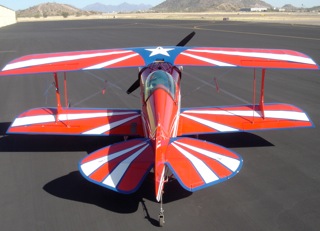 With thousands of hours looking at an AoA, he now owns a Baron and competes in Advanced Level aerobatics in his georgeous Pitts. Here he offers his thoughts on the AoA in my King Air: With thousands of hours looking at an AoA, he now owns a Baron and competes in Advanced Level aerobatics in his georgeous Pitts. Here he offers his thoughts on the AoA in my King Air:
"I hate driving down the freeway, in heavy traffic, when some lousy driver will simultaneously turn on a blinker and immdeiately cut in front of me. I have to slam on the brakes and worry about getting hit from behind.
"When I started flying, I would always use my vertical speed indicator to maintain level flight because it's the most accurate altitude trend gauge in the cockpit. (I know, I know...it has some problems and the altimeter should always be used). I still use vertical speed as early warning of an altitude deviation; then I look back at the altimeter.
"So....what do the two above statements have to do with anything? I'll try to clarify what came to mind when I used the Legacy AoA display in the King Air 90:
"Almost every certified airplane in the United States has an AoA indicator already. It's called the stall warning and it works just fine. It doesn't need an airspeed indicator to work at all. The problem is that it's just like the inconsiderate driver who cuts you off in traffic. You get the warning ... but it's almost too late to do anything about it. (Here, I'm talking about when it comes on unexpectedly, not when you're out doing stall practice).
"The AoA behaves more like the thoughtful driver who signals his intentions well before the lane change and gives you time to adjust your behavior to help avoid a collision.
"Another thing the AoA does for you is that it helps calibrate your airspeed indicator for the approach to be flown. In Fred's King Air, the copilot's airspeed indicator read about 10 kts slower that the pilot's side. It didn't matter, because when I got the "green doughnut" I looked back to the airspeed indicator and flew that particular airspeed to maintain the green doughnut. The AoA doesn't care what your airspeed indicator says. If the AoA has been calibrated properly, it'll tell you the proper airspeed to fly final. I hope I'm saying this properly but what I mean is that you can use the AoA to find the indicated airspeed to fly the approach, and then use the airspeed indicator to fly the approach because the airspeed indicator is your most accurate trend monitor.
"And now, let's talk about another feature. Fred's AoA gives you a 'Getting Slow' aural warning [a female voice warning too, as of 3/18/2011]. when you pass below a certain speed [it's "angle of attack," actually]. Just think how nice it would be to have such a gentle warning when our speed decays below, let's say 80 kts on approach in my Baron. (Let's see: you're on base trying to slow below 100kts when ATC throws you a curve ball. You look down at your approach plate, trying to figure out what he's talking about when you get a warning that you've just gone below 80 kts. You go "dammit", add a little power, stabilize things, then go back to trying to figure out what the controller just said). No harm, no foul ... because you had plenty of warning that you were slowing.
"Is the AoA a useful tool? Hell, Yes!
(Note: Immediately after this flight, Jack bought a Legacy AoA for his Baron).
"Would it be a good idea for flight schools to have and teach? Yes!"
Note: We are NOT SUGGESTING that light aircraft pilots suddenly become Marine or Naval Aviators to land on a moving deck at sea, or bush pilots who need to squeeze out every ounce of performance.
For me, an early warning of impending stall is a gracious plenty good deal for ~$550-$1,500 plus a few hours of installation. C.K. Lee was in the right seat as we landed at Georgetown with gusts to 29Kts, and we made the first turn off, hardly trying. Green ball all the way down. Very comforting.
Jack Stovall [with his thousands of flying hours as an Air Force Chief Instructor Pilot] then commented quietly: “... most pilots do not know that a plane can fly so comfortably, so safely, so slow..."
Jack wrote that in early 2011. More recently, having installed the Legacy AoA in his Baron and having flown it for a considerable time, he expanded his review: (on BeechTalk 4/26/12):
"The AoA and the Airspeed indicator are both trend monitors and stall warning indicators. The AoA is looking at angle to the relative wind and the airspeed is looking at the force of the pressure caused by the relative wind. They are both totally independent of each other looking at two completely different variables to let you know when a stall is coming. The airspeed indicator lets you know with a needle or digital readout and the AoA (Legacy) lets you know with lights and aural warnings. If the AoA says you're getting slow and the airspeed doesn't ... believe the AoA. If the airspeed indicator says you're getting slow and the AoA doesn't ... believe your airspeed indicator.
"The one "gotcha" to the AoA is this: Long final descending turn, 30 deg bank, idle power and the only thing you're looking at is the runway and the AoA (because it's so bulletproof). Your airspeed is slowly falling and falling (because you're not paying any attention to it) but you still keep looking at the runway and the green donut AoA. If you do not have more than one "G" of backpressure, the AoA is still detecting the relative wind at the same angle, you're still going to get the "on speed" indication. If I had an AoA on my Pitts, I could probably show you on-speed AoA indications at 15 kts.
"ALWAYS USE THE AoA AND THE AIRSPEED INDICATOR AS A TEAM!
"I like my Legacy AoA display because I can mount it as a "Heads Up" display right in my line of sight on the glareshield. That way, when I'm looking outside, it's right in front of me. I like the mechanical display, too, since it uses an analog display which really makes trend monitoring much easier to follow.
"So, is an AoA necessary or is nice to have? The answer to the first part of the question is easy, No. The answer for the second part of the question is also easy, Yes.
"Is it worth the cost? In my opinion, Yes.....".
But there is NOTHING really new about any of this. Hear from Robert Blodgett, Contributing Editor of FLYING Magazine, November 1971:
“Two things are certain: The first is that AoA indicators could do more than anything else in the history of powered flight to reduce accidents, especially fatals. The second is that only customer demand can convince manufacturers that people want “Alpha”.
“Stall warning devices are … binary or ‘On-Off’ devices that give the pilot no indication whatever on how close his wing is to stall….one or two degrees [of angle of attack] below stall, a [stall warning device] is still speechless, mute.
It is at its most awkward, tongue-tied phase just when the pilot needs it most..."
BINGO! A wiser sentence on aviation instrumentation may have never been written.
Tom Rosen is a retired 20,000 hour TWA Captain. He's my co-leader in this AoA educational effort. His Beech S-35 Bonanza has the early version of an Alpha Systems Classic Horizontal AoA.
"Angle of Attack 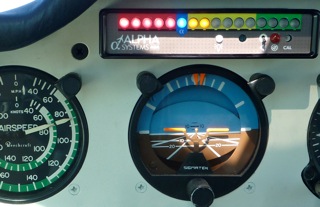 is so simple. It's Muy Importante in agricultural aircraft; their weight changes constantly, with steep banks, and ZERO room for recovery. They often fly at minimum airspeed to do a high quality job of application and to avoid wasting time in a quick pull-up to a steep bank in a tight reversing turn... all done with greatly-varying loads. The IAS doesn't really provide them with what they need for that. AoA does. I remember looking at an old Stearman years ago and the only instrument in the cockpit that worked (besides the engine gauges) was an Angle Of Attack gauge. Blew me away. is so simple. It's Muy Importante in agricultural aircraft; their weight changes constantly, with steep banks, and ZERO room for recovery. They often fly at minimum airspeed to do a high quality job of application and to avoid wasting time in a quick pull-up to a steep bank in a tight reversing turn... all done with greatly-varying loads. The IAS doesn't really provide them with what they need for that. AoA does. I remember looking at an old Stearman years ago and the only instrument in the cockpit that worked (besides the engine gauges) was an Angle Of Attack gauge. Blew me away.
I've got well north of 20,000 hours without an AoA. I now am happy to say that the most recent 25 hours or so are WITH Angle of Attack instrumentation. My eyes have been opened! I now find it incredible that AoA was not made standard equipment on all aircraft many years ago. It is a great instrument and the more experience I have with it, the more I am relying on it. Slow speed maneuvering, best rate or best angle of climb...it's right there in front of me -- regardless of my gross weight or bank angle, or the density altitude. I'm a A&P myself; it was an easy installation, and it was definitely a "Minor Alteration."
HUGELY IMPORTANT! ... RECENT NEWS! ...
June 2015--in the , the FAA is making a big push to get AoA indicators installed in General Aviation aircraft.
Earlier,
in its extraordinarily helpful December 2011 FAA clarification letter, the FAA Small Aircraft Directorate explains that installation is a "minor alteration" on the vast majority of light general aviation aircraft.
The most experienced aviators ALL agree that AoA is the way to go. Here's more from pilots who know; every one is a Navy or Marine Aviator. |






